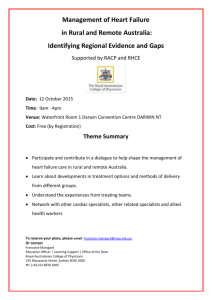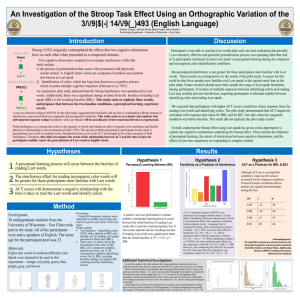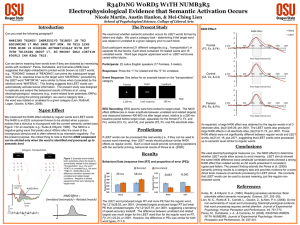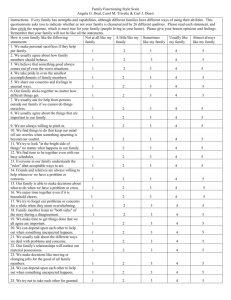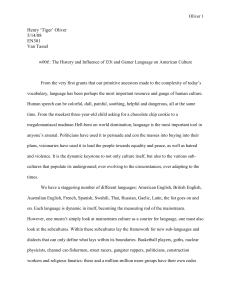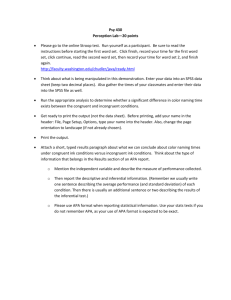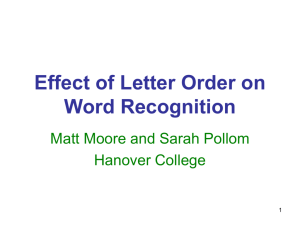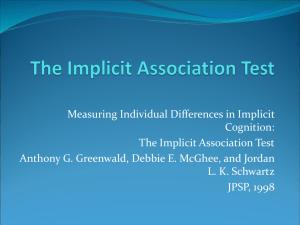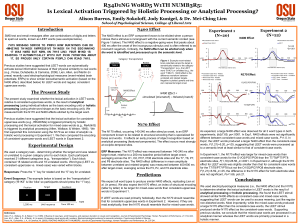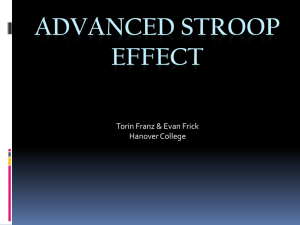SchielSpr2012
advertisement
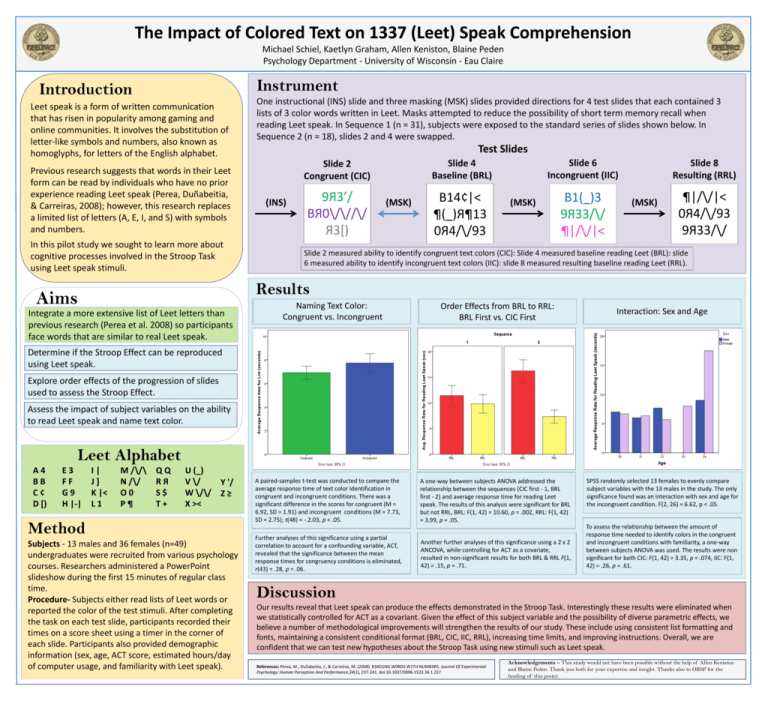
The Impact of Colored Text on 1337 (Leet) Speak Comprehension Michael Schiel, Kaetlyn Graham, Allen Keniston, Blaine Peden Psychology Department - University of Wisconsin - Eau Claire Instrument Introduction Leet speak is a form of written communication that has risen in popularity among gaming and online communities. It involves the substitution of letter-like symbols and numbers, also known as homoglyphs, for letters of the English alphabet. Previous research suggests that words in their Leet form can be read by individuals who have no prior experience reading Leet speak (Perea, Duñabeitia, & Carreiras, 2008); however, this research replaces a limited list of letters (A, E, I, and S) with symbols and numbers. In this pilot study we sought to learn more about cognitive processes involved in the Stroop Task using Leet speak stimuli. One instructional (INS) slide and three masking (MSK) slides provided directions for 4 test slides that each contained 3 lists of 3 color words written in Leet. Masks attempted to reduce the possibility of short term memory recall when reading Leet speak. In Sequence 1 (n = 31), subjects were exposed to the standard series of slides shown below. In Sequence 2 (n = 18), slides 2 and 4 were swapped. Test Slides (INS) Slide 2 Congruent (CIC) Slide 4 Baseline (BRL) Slide 6 Incongruent (IIC) Slide 8 Resulting (RRL) 9Я3’/ BЯ0\/\//\/ Я3[) B14¢|< ¶(_)Я¶13 0Я4/\/93 B1(_)3 9Я33/\/ ¶|/\/|< ¶|/\/|< 0Я4/\/93 9Я33/\/ (MSK) (MSK) (MSK) Slide 2 measured ability to identify congruent text colors (CIC): Slide 4 measured baseline reading Leet (BRL): slide 6 measured ability to identify incongruent text colors (IIC): slide 8 measured resulting baseline reading Leet (RRL). Results Aims Integrate a more extensive list of Leet letters than previous research (Perea et al. 2008) so participants face words that are similar to real Leet speak. Naming Text Color: Congruent vs. Incongruent Order Effects from BRL to RRL: BRL First vs. CIC First Interaction: Sex and Age Determine if the Stroop Effect can be reproduced using Leet speak. Explore order effects of the progression of slides used to assess the Stroop Effect. Assess the impact of subject variables on the ability to read Leet speak and name text color. Leet Alphabet A4 BB C¢ D [) E3 FF G9 H |-| I| J] K |< L1 M /\/\ N /\/ O0 P¶ QQ RЯ S$ T+ U (_) V \/ Y '/ W \/\/ Z ≥ X >< Method Subjects - 13 males and 36 females (n=49) undergraduates were recruited from various psychology courses. Researchers administered a PowerPoint slideshow during the first 15 minutes of regular class time. Procedure- Subjects either read lists of Leet words or reported the color of the test stimuli. After completing the task on each test slide, participants recorded their times on a score sheet using a timer in the corner of each slide. Participants also provided demographic information (sex, age, ACT score, estimated hours/day of computer usage, and familiarity with Leet speak). A paired-samples t-test was conducted to compare the average response time of text color identification in congruent and incongruent conditions. There was a significant difference in the scores for congruent (M = 6.92, SD = 1.91) and incongruent conditions (M = 7.73, SD = 2.75); t(48) = -.2.03, p < .05. Further analyses of this significance using a partial correlation to account for a confounding variable, ACT, revealed that the significance between the mean response times for congruency conditions is eliminated, r(43) = .28, p = .06. A one-way between subjects ANOVA addressed the relationship between the sequences (CIC first - 1, BRL first - 2) and average response time for reading Leet speak. The results of this analysis were significant for BRL but not RRL, BRL: F(1, 42) = 10.60, p = .002, RRL: F(1, 42) = 3.99, p = .05. Another further analyses of this significance using a 2 x 2 ANCOVA, while controlling for ACT as a covariate, resulted in non-significant results for both BRL & RRL F(1, 42) = .15, p = .71. SPSS randomly selected 13 females to evenly compare subject variables with the 13 males in the study. The only significance found was an interaction with sex and age for the incongruent condition. F(2, 26) = 6.62, p < .05. To assess the relationship between the amount of response time needed to identify colors in the congruent and incongruent conditions with familiarity, a one-way between subjects ANOVA was used. The results were non significant for both CIC: F(1, 42) = 3.35, p = .074, IIC: F(1, 42) = .26, p = .61. Discussion Our results reveal that Leet speak can produce the effects demonstrated in the Stroop Task. Interestingly these results were eliminated when we statistically controlled for ACT as a covariant. Given the effect of this subject variable and the possibility of diverse parametric effects, we believe a number of methodological improvements will strengthen the results of our study. These include using consistent list formatting and fonts, maintaining a consistent conditional format (BRL, CIC, IIC, RRL), increasing time limits, and improving instructions. Overall, we are confident that we can test new hypotheses about the Stroop Task using new stimuli such as Leet speak. References: Perea, M., Duñabeitia, J., & Carreiras, M. (2008). R34D1NG W0RD5 W1TH NUMB3R5. Journal Of Experimental Psychology: Human Perception And Performance,34(1), 237-241. doi:10.1037/0096-1523.34.1.237 Acknowledgements – This study would not have been possible without the help of Allen Keniston and Blaine Peden. Thank you both for your expertise and insight. Thanks also to ORSP for the funding of this poster.
